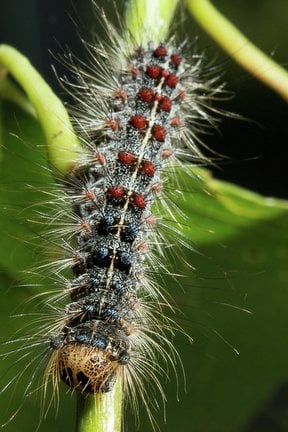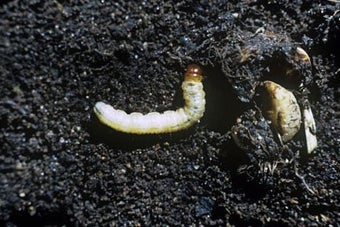
Quick facts
Common name - Vapourer moth
Scientific name - Orgyia antiqua
Plants affected - Birch (Betula), hazel (Corylus), lime (Tilia) and many other broadleaved trees and shrubs including Cotoneaster and Pyracantha
Main symptoms - Hairy caterpillars, grey-black with yellow tufts and red spots (30-40 mm long)
Most active - Spring to summer
What is vapourer moth?
Vapourer moth, also known as rusty tussock moth, are sexually dimorphic (males and females are different in appearance as adults). The males have plain orange-brown wings (wingspan 25-30 mm) with a white spot near the trailing edge of the forewing, whilst the females have an enlarged light grey-brown body with greatly reduced wings and are unable to fly. Males are attracted to the female by a scent that she emits (sex pheromone). After mating, the female deposits her eggs over the surface of the pupal cocoon. These eggs will overwinter and hatch during the following spring.
It is the caterpillars that are particularly eye-catching and it is this stage that is most often noticed in gardens. The caterpillars are predominantly grey-black with small red spots running in rows down both sides of the body; the most easily recognisable features are the four yellow tufts of hair-like setae found towards the head end.

Symptoms
Caterpillars cause a slight defoliation of host plants. Larval food plants include most native broadleaved trees and shrubs such as birch, blackthorn, elm, hawthorn, hazel, lime, oak and willow, as well as many cultivated plants including cotoneaster and pyracantha. In some cases evergreen trees and shrubs are eaten.
The caterpillars are present on plants from late April to August and when fully grown will pupate within a silken cocoon on or nearby their host plant. The adult moths emerge August to September.
Management
The presence of the caterpillars of this moth rarely cause significant damage in gardens and it can usually be tolerated. Caterpillars and associated moths are important as a food source for other garden wildlife and so should be preserved where possible.
- Where possible tolerate populations of caterpillars, as butterflies and moths are an important part of the garden ecosystem
- Encourage predators and other natural enemies in the garden such as birds, hedgehogs and ground beetles
- Check plants regularly from late April for the presence of larvae and remove by hand where practical. When handling the caterpillars gloves can be worn as a precaution, although the hairs are visually striking they do not usually cause irritation.
- Caterpillars can be removed to larger host plants; on larger trees and shrubs whilst some parts of the plant may be defoliated this will have no effect on the long term health of the host plant and so can be tolerated
- If the egg-covered cocoons, on which this species overwinters, are spotted these could be removed to another host plant elsewhere in the garden











